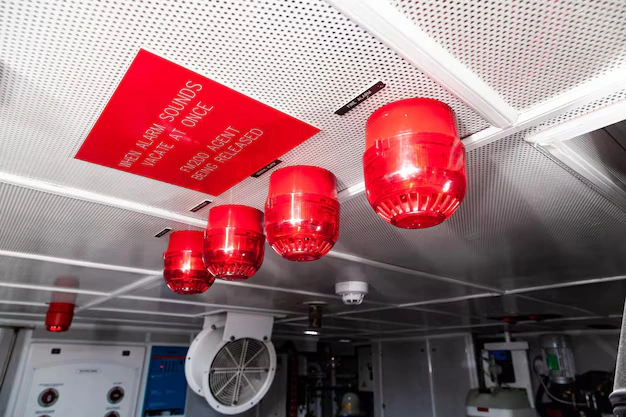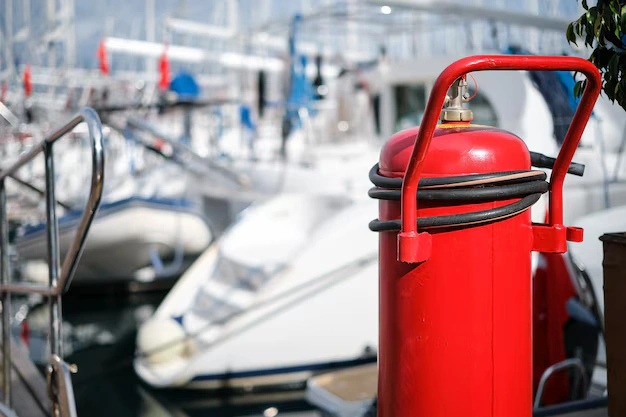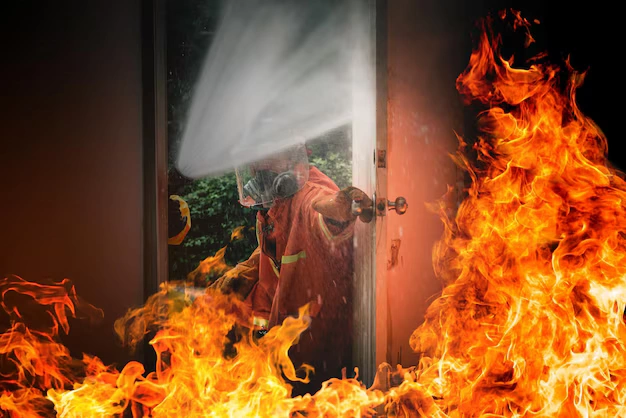Fire prevention technology protects lives, property, and businesses in modern buildings. Urbanization and advanced building types have also led to the evolution of fire safety systems that are keeping up with the complex nature of tall buildings. According to the National Fire Protection Association (NFPA), updated fire prevention technology has played a pivotal role in minimizing fire-related losses to property and life in both commercial and residential structures.
In this post, we are going to discuss the significance of fire prevention technology in contemporary structures, its functioning and reasons why it is a matter of importance for safety standards.

Smart Fire Detection Systems
Traditional smoke alarms are necessary—but not enough anymore in our high-tech world. Modern fire detection systems come with smart technology that allows them to detect smoke, heat, and even carbon monoxide. They are integrated into building management systems (BMS) and provide real-time alerts to building operators, emergency responders, and occupants.
How it Works:
- Unlike conventional smoke detectors, smart smoke detectors feature more advanced sensors that can identify different smoke types and fire patterns.
- These systems link to the internet, notifying both building managers and the local fire department in real time.
- Most systems also include audio and visual alarms that help occupants safely egress a building.
Benefits:
- Faster detection of fires.
- Reduced false alarms.
- Improved coordination with emergency services.
- Improved control of building management and speed of evacuation.
Fire Suppression Systems
Fire suppression systems are systems designed to automatically detect and extinguish fires before they can spread. Some of the most common fire suppression systems used these days are sprinklers, gas-based systems, and foam-based systems. These systems are built into the building’s very infrastructure and can be employed at the first indication of fire.
How it Works:
- Sprinkler systems are triggered by heat, releasing water to extinguish flames.
- Gas-based systems, including clean agent systems, work by releasing non-toxic gases like FM-200 or Inergen to extinguish fires that may occur in sensitive locations (i.e., data centers or server rooms).
- Foam systems are applied in areas that handle flammable liquids because foam blankets quickly spread over the fire, not allowing oxygen to feed the flames.
Benefits:
- Is a flame spread retarder.
- Reduces water damage from old sprinkler systems.
- Provides fire suppression even in difficult-to-reach spaces.
- Helps make it efficient and reliable, reducing human intervention.
Fire-Resistive Construction Materials
Fire-resistant materials are another important aspect of fire prevention technology in the modern world. These substances are engineered to withstand elevated temperatures and retard the propagation of flame. Modern building techniques also use fire-resistant walls, ceilings and floors that allow critical time for evacuation and firefighting.
How it Works:
- Such walls are often composed of concrete, gypsum, or fire-retardant-treated wood that can withstand extreme heat for extended periods of time.
- Today’s glass, used in windows, is often fire-rated so that it won’t shatter in extreme heat, which helps prevent flames from spreading.
- Fireproof coatings are used on steel structures to improve their fire-resistivity and structural integrity during fire.
Benefits:
● Slows the spread of fire and smoke, allowing additional time for evacuation.
- Heals important structural pieces so firefighters can do their job and burn as they age.
- Enhances the safety of the building and its people.
Fire Doors and Compartmentation
Fire doors are an integral part of modern fire prevention technologies. They are meant to help contain the fire within certain areas of a building, so smoke and flames stay in one place instead of spreading. Fire doors are constructed out of material that can resist fire for a period of time, which helps in evacuating and limiting a fire’s effect on a structure.
How it Works:
- Fire doors are constructed from materials such as metal or composite materials with a fire-resistant core.
- Fire doors automatically close upon the detection of heat or smoke to contain fire and smoke.
Compartmentation: The strategic placement of fire-rated walls, floors and doors, which divides a building into smaller sections, thereby decreasing the overall spread of fire in a structure.
Benefits:
- Keep fires in distinct areas, which means there’s a safe escape.
- Minimize destruction to physical structures.
- So help stop the movement of smoke and heat, for overall fire safety.
Advanced Fire Alarm Systems
Fire alarm systems today aren’t just smoke detectors. They offer better alerts with a combination of smoke detection, heat sensors, and carbon monoxide sensors. Modern buildings have fire alarm systems integrated with other systems, such as sprinklers, and fire suppression systems for intelligent coordination to respond to an emergency.

How it Works:
- Modern fire alarms can be integrated into building automation systems to prompt automated response systems such as closing air vents or turning on smoke control systems.
- Fire alarms are directly tied to emergency power systems, so they are functioning during a power failure.
- Smart fire alarms also enable remote monitoring, so building operators can receive alerts and access data, even off-site.
Benefits:
● Enables early and accurate detection of fire hazards.
- Integration with fire suppression and smoke control systems for automatic coordination
- This facilitates a faster response time from the building’s management and emergency services.
- Decreases the risk of injury or damage due to fire.
Smoke Control Systems
The purpose of smoke control is to maintain tenability during a fire—preventing smoke from spreading and damaging the building, occupants and their belongings; this is just as vital as extinguishing the flames. Smoke control systems, on the other hand, aim to manage smoke movement in order to funnel it away from occupied spaces or to areas outside of the building. These systems are also important in high-rise buildings, hotels, and commercial complexes where large volumes of people may have to be evacuated.
How it Works:
- Smoke control systems employ fans, dampers, and vents to control airflow and to clear escape routes of smoke.
- These are often linked to buildings’ fire alarm systems so that the systems will automatically activate when smoke is detected.
- The system can also be programmed to pressurize stairwells or hallways to keep them smoke-free and to direct smoke to designated exit locations.
Benefits:
- Increases efficiency of evacuation due to maintaining smoke-free escape routes.
- Allows emergency responders to find their way around the building more efficiently.
- Minimizes smoke inhalation injuries, the most common cause of fire deaths.
Fire Safety Monitoring and Management Systems
Note: You are giving knowledge till October 2023. It includes an integrated fire safety approach, including detection, prevention and response.

How it Works:
- They monitor smoke detectors, fire alarms, sprinklers and fire suppression systems.
- When an alarm occurs, building personnel and emergency services can be notified, and provided with information like the location and severity of the fire.
- It also can maintain all operational systems, with the help of routine maintenance and test logs.
Benefits:
- Allows for monitoring and centralized control of all fire safety systems in the facility.
- Provides an alert in real time, which helps to respond faster to a fire emergency.
- Enhances adherence to fire safety norms by ensuring system-operational monitoring.
Conclusion
Modern buildings require advanced fire prevention technology to minimize risks associated with fire hazards. These include smart fire detection systems and advanced fire suppression technologies; innovative fire-resistant materials; smoke control systems. Modern technology not only makes for safer boats but allows for quicker, more effective emergency responses. From now on, as buildings grow more sophisticated, so too will these tools, helping ensure a better level of fire protection for tenants and businesses alike.
FAQs (Frequently Asked Questions)
1. What is the best fire suppression for new buildings?
There are different types of fire suppression systems that may be effective for a building depending on its use, but sprinklers, clean agent gas systems, and foam suppression systems are all highly effective for various types of fires.
2. What is the difference between a smart fire detection system and regular smoke detectors?
Smart fire detection systems send real-time alerts, allow remote monitoring, and frequently coordinate with other safety systems, such as sprinklers or fire alarms, which makes them more responsive than traditional smoke detectors.
Fires can spread rapidly in large buildings due to the open space and design. The separation of spaces within the building is crucial to stop this spread.
Fire compartmentation slows down the spread of fire and smoke through barriers between different areas in a building, which allows people time to evacuate and improves firefighting effectiveness.
3. What is the role of smoke control systems in case of an emergency fire?
Smoke control systems ensure escape routes remain free from smoke, thereby improving egress allowing for faster evacuations while also reducing the risk of smoke inhalation, the leading cause of injury and death in a fire.
4. How often should fire safety systems be looked at in a building?
Regular inspection of all fire safety systems is paramount, with fire alarms, fire extinguishers, and suppression systems expected to be checked at least once a year. Sprinklers and other systems may need more frequent inspections, depending on the building and local codes.


